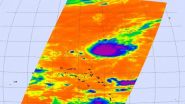(Press-News.org) 15 July, 2015, Hoffman Estates, IL - Sodium intake in the U.S. exceeds dietary recommendations and has been identified as a nutrient of public health concern in the Scientific Report of the 2015 Dietary Guidelines Advisory Committee1 due to its link to increased risk of hypertension, heart disease, and stroke2. While authorities continue to call for people to lower their sodium intake, much progress still needs to be made and multiple solutions are necessary to meet the recommended maximum intake of 2,300 milligrams per day for the general population and 1,500 milligrams per day for at-risk groups3. Two recent dietary modeling studies assessed the potential impact of a sodium reduction ingredient on sodium intake for both the general population as well as ethnic population subgroups, and extrapolated future healthcare cost savings associated with reduced blood pressure that could be achieved with reductions in sodium intake.
New research, published this month in Food Science & Nutrition, provides the most recent estimates of sodium intake among the U.S. population and assesses the potential impact of a sodium reduction technology on sodium intake via a modeling analysis4. Using National Health and Nutrition Examination Survey (NHANES) 2007-2010 data that included over 17,000 participants, the study found that sodium reduction using Tate & Lyle's SODA-LO® Salt Microspheres could potentially decrease sodium intake by 230-300 milligrams per day or about 7-9% of total sodium intake among the U.S. population depending on age and gender group. SODA-LO® Salt Microspheres is a salt-reduction ingredient that can reduce sodium in certain foods through its technology, which turns standard salt crystals into hollow salt microspheres that efficiently deliver salt taste and functionality by maximizing surface area.
Changing consumer behavior is difficult, and some attempts to encourage individuals to lower dietary salt intake have largely proven to be ineffective5. Thus, using technology like SODA-LO® Salt Microspheres could be instrumental in improving dietary intake and health among the U.S. population. The potential decrease of sodium intake by 300 milligrams per day in adults age 19-50 years is predicted to reduce systolic blood pressure by 0.45 to 0.88 mm Hg and potentially yield US$3.0 to US $5.3 billion in healthcare cost savings annually4.
A second study published in Nutrition Journal also used NHANES 2007-2010 data to model the potential impact of SODA-LO® Salt Microspheres on sodium intake in ethnic population subgroups who have higher risk for hypertension and associated diseases6. Based upon potential usage of SODA-LO® Salt Microspheres, there was a reduction of 185-323 milligrams sodium per day, which translates to a 6.3-8.4% reduction of current sodium intake in ethnic population subgroups, representing a meaningful reduction in these subgroups whose current intake exceeds recommendations.
"Together, these two studies demonstrate how ingredient technologies like SODA-LO® Salt Microspheres can provide immediate solutions to reducing sodium intake while meeting consumer taste preferences, and ultimately improving public health," said Michael Harrison, PhD, Senior Vice President, New Product Development, Innovation and Commercial Development at Tate & Lyle. "Tate & Lyle is committed to providing food manufacturers with effective solutions that can help consumers lower their sodium intake and meet their current health and wellness needs."
INFORMATION:
For more information contact:
Media Relations
Tate & Lyle PLC
PRenquiries@tateandlyle.com
About Tate & Lyle:
Tate & Lyle is a global provider of ingredients and solutions to the food, beverage and other industries, with operations in over 30 locations worldwide.
Tate & Lyle operates through two global divisions, Speciality Food Ingredients and Bulk Ingredients, supported by our Innovation and Commercial Development and Global Operations groups. The Group's strategy is to become a leading global provider of Speciality Food Ingredients through a disciplined focus on growth, and by driving Bulk Ingredients for sustained cash generation to fuel this growth.
Speciality Food Ingredients consists of three platforms: Texturants, which includes speciality starches and stabilisers; Sweeteners, which comprises nutritive sweeteners and our range of no-calorie sweeteners including SPLENDA® Sucralose; and our Health and Wellness portfolio which includes speciality fibres and our salt-reduction offerings. Additionally, our Food Systems business provides a wide variety of blended ingredient solutions.
Tate & Lyle Bulk Ingredients includes bulk sweeteners, industrial starches and fermentation products (primarily acidulants). Corn co-products from both divisions are primarily sold as animal feed.
Tate & Lyle is listed on the London Stock Exchange under the symbol TATE.L. American Depositary Receipts trade under TATYY. In the year to 31 March 2015, Tate & Lyle sales totalled £2.7 billion.
For more information, please visit http://www.tateandlyle.com.
SPLENDA® is a trademark of McNeil Nutritionals, LLC.
References:
U.S. Dietary Guidelines Advisory Committee. Scientific Report of the 2015 Dietary Guidelines Advisory Committee. Advisory Report to the Secretary of Agriculture and the Secretary of Health and Human Services. Washington, DC: U.S. Department of Agriculture, Agricultural Research Service. February 2015.
Roger VL, Go AS, Lloyd-Jones DM, et al. Heart disease and stroke statistics-2012 update: a report from the American Heart Association. Circulation. 2012;125:e2-220.
U.S. Department of Agriculture and U.S. Department of Health and Human Services. Dietary Guidelines for Americans, 2010. 7th Edition, Washington, DC: U.S. Government Printing Office, 2010.
Agarwal, S., Fulgoni, V. L., Spence, L. and Samuel, P. (2015), Sodium intake status in United States and potential reduction modeling: an NHANES 2007-2010 analysis. Food Science & Nutrition. doi: 10.1002/fsn3.248.
Hooper L, Bartlett C, et al. Systematic review of long term effects of advice to reduce dietary salt in adults. Brit Med J. 2002;325(7365):628.
Fulgoni VL, Agarwal S, Spence L, Samuel P. Sodium intake in US ethnic subgroups and potential impact of a new sodium reduction technology: NHANES dietary modeling. Nutr J. 2014;13:120.
Mainz/Barcelona. A team of scientists at the Max Planck Institute for Polymer Research (MPI-P) discovered that electrical conduction in graphene on the picosecond timescale - a picosecond being one thousandth of one billionth of a second - is governed by the same basic laws that describe the thermal properties of gases. This much simpler thermodynamic approach to the electrical conduction in graphene will allow scientists and engineers not only to better understand but also to improve the performance of graphene-based nanoelectronic devices.
The researchers found that ...
Researchers at Harvard University and the University of California, San Diego, have developed a new user-friendly resource to accompany the powerful gene editing tool called CRISPR/Cas9, which has been widely adopted to make precise, targeted changes in DNA. This breakthrough has the potential to facilitate new discoveries in gene therapies and basic genetics research. The research was published in the July 13 issue of Nature Methods.
The study describes an approach to simplify a laborious part of the gene editing process using the CRISPR/Cas9 system: choosing the best ...
Sudden unexpected death in epilepsy (SUDEP) is becoming increasingly recognized as a very real and devastating problem in which impaired breathing is thought to play a critical role. Researchers believe breathing may be impaired during and after seizures, without the patient's knowledge.
By using electrical stimulation to activate the amygdala, a group of University of Iowa researchers has identified areas of the human brain in which breathing is controlled and, in some cases, impaired, providing an important insight into SUDEP.
Their study - which marks the first time ...
NASA's Aqua satellite flew over Typhoon Halola in the northwestern Pacific Ocean and captured temperature data on the storm. Satellite data showed that wind shear is affecting the stubborn storm.
NASA's Aqua satellite passed over Halola on July 14 at 20:20 UTC (4:20 p.m. EDT/1:20 p.m. PDT) infrared data from the Atmospheric Infrared Sounder or AIRS instrument that also flies aboard Aqua showed cloud top temperatures were as cold as -63F/-52C. Cloud top temperatures that cold have the ability to drop heavy rainfall.
The Joint Typhoon Warning Center noted that animated ...
High school students who take part in pre-college programs that focus on science are much more likely to pursue higher education and, eventually, careers in science, technology, engineering and medicine - the STEM disciplines.
In a paper published in the Journal of Higher Education Outreach and Engagement, Michigan State University researchers from the National Superconducting Cyclotron Laboratory, the Joint Institute for Nuclear Astrophysics and the College of Education used an MSU program as a case study for why these programs are key to training tomorrow's generation ...
PHILADELPHIA, PA - July 15, 2015 - Obstructive Sleep Apnea (OSA) remains under-recognized in hospitalized patients, despite being associated with cardiovascular complications and sudden death. A multi-disciplinary group of researchers and physicians at Thomas Jefferson University and Hospitals have created a clinical pathway, or screening process, to identify the disorder in higher-risk, hospitalized patients and recently published the results in the Journal of Clinical Sleep Medicine.
"The results showed that our screening process identified sleep disordered breathing ...
New York, NY, July 15, 2015--Researchers at Columbia University Medical Center (CUMC) have found that key parts of the human brain network that give us the power to control and redirect our attention--a core cognitive ability--may be unique to humans. The research, which was published in the July 13 online edition of the Proceedings of the National Academy of Sciences, suggests that the network may have evolved in response to increasingly complex social cues.
"The human brain is powerful, but even it cannot make sense of the entire sum of stimuli that bombard our senses," ...
ROSEMONT, Ill.--Patients who received rehabilitation instructions via video teleconference, or "telerehabilitation," following total knee replacement (TKR) surgery had comparable outcomes to patients who received in-person physical therapy, according to a study appearing in the July 15 issue of The Journal of Bone & Joint Surgery (JBJS).
"This study is the first to provide strong evidence for use of telerehabilitation as an alternative to conventional face-to-face care following total knee replacement surgery," said Hélène Moffet, PhD, lead study author, physical ...
JUPITER, FL, July 15, 2015 - As early as 1943, when autism was first described by psychiatrist Leo Kanner, reports were made that some, but not all, children with autism spectrum disorder have relatively enlarged heads. But even today, more than half a century later, the exact cause of this early abnormal growth of the head and brain has remained unclear.
Now, scientists from the Florida campus of The Scripps Research Institute (TSRI) have uncovered how mutations in a specific autism risk gene alter the basic trajectory of early brain development in animal models.
The ...
Montreal, July 15, 2015 - A Canadian research team at the IRCM in Montreal, led by molecular virologist Eric A. Cohen, PhD, made a significant discovery on how HIV escapes the body's antiviral responses. The team uncovered how an HIV viral protein known as Vpu tricks the immune system by using its own regulatory process to evade the host's first line of defence. This breakthrough was published yesterday in the scientific journal PLOS Pathogens and will be presented at the upcoming IAS 2015 conference in Vancouver. The findings pave the way for future HIV prevention or cure ...




